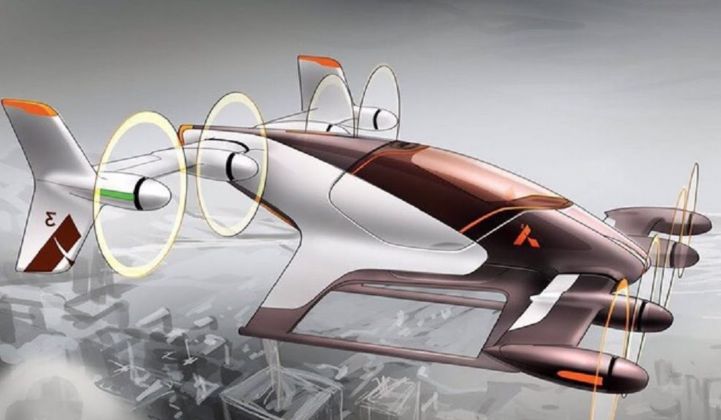There’s a lot of excitement around flying cars right now -- even if they are basically just giant drones. Whether piloted or autonomous, taxis or private vehicles, they’ve been hailed by futurists as the ideal way to reduce journey times across urban landscapes, thus easing city road congestion.
But despite the media hype (or perhaps because of it), there are reasons to be skeptical of this vision.
Big names including Uber, Airbus and Larry Page are taking a keen interest. Toyota wants to get its prototype ready for the 2020 Olympic Games in Tokyo. A group of startups including E-volo, Terrafugia, AeroMobil, Zee.Aero and Moller International have prototypes ready or in the pipeline.
As GTM reported recently, ChargePoint even says it’s preparing to charge flying vehicles, and Dubai has announced a driverless flying taxi service using foldable, one-seater Ehang 184 drones. The service is set to take off next month.
Last month, Uber hosted the three-day Elevate Summit to accelerate “the future of on-demand urban air transportation.” The ride-hailing company even produced a white paper last year on how to realize that vision.
The 97-page document addresses everything from battery requirements to pilot training, transport hub placement, safety, noise and sustainability. Uber concluded that batteries are not yet ready in terms of energy density, charging times and cycle life. It also says battery costs are way too high, but believes those will keep improving with economies of scale.
There may be a pilot bottleneck, too. But “pilot augmentation technology will significantly reduce pilot skill requirements," concluded Uber.
Other enthusiasts insist there will be no need for pilots at all, as these craft will be totally autonomous -- and all the safer for it.
This speculation is a big part of the problem, said Mike Manville, assistant professor of urban planning at UCLA. “A lot of technological pundits make the same tautological argument: ‘It will be cheap and safe, because technology will be invented which will make it cheap and safe.’"
And despite claims of being “clean” transportation, a huge fleet of flying, electric drone-cars would place massive additional energy demands on generating infrastructure.
Mark Bunger, VP of research at Lux Research, said: “There are, as of now, no credible analyses of the systemic impact of these (still hypothetical) vehicles on cities or traffic, or the environment as a whole.”
In one scenario, they would take the place of long-distance taxi rides. If that's all they replace, that's a vanishingly small number of trips and would have zero measurable impact on anything.
On the other hand, said Bunger, “having inexpensive, autonomous vehicles on land or in the air could vastly increase the overall amount that we travel, much the way that we get and send [many] more messages to more people now than we did when we only had paper letters and landlines. Then they would have a huge impact simply because we would be flying so much more.”
This relates to one of the central claims from Uber and others regarding urban air travel -- that it would reduce congestion for existing traffic. This, said Manville of UCLA, is pure nonsense.
“Roads are overused and underpriced commodities,” he said. “The only way that has ever been shown to reduce congestion -- in the history of the world, ever -- is road pricing.”
He cited London and Helsinki as good, but rarely copied, examples of where road pricing has been effective. “Reducing road congestion and providing some people with a way to avoid it are two entirely different ideas,” said Manville.
Uber’s claim that it will enable cheap urban air travel for everyone is also highly suspect, said Manville.
The high costs of ensuring the safety of airliners through multiple redundant systems only make sense because the plane is nearly always in the air and filled with several hundred passengers. When built into a craft designed for one or two passengers, the math starts to look suspect, he said.
Professor Glenn Lyons, associate dean for research and enterprise at the University of the West of England, and a highly regarded authority on transportation, said the claims of the feasibility of flying taxis are “apocryphal.”
“Self-driving private aircraft seem to be considered in the media as simply an extension of self-driving cars," said Lyons. These characterizations don't take into account the vast new challenges associated with this new and still largely theoretical form of transportation. Self-driving cars on roads are challenging enough.
Howard Jennings, the managing director of Mobility Lab, said planning will be daunting: “The thought of millions of privately owned flying cars should raise red flags, just like personal cars should have decades ago. We’re already learning from projections that driverless vehicles could make traffic worse if we don’t make smart planning decisions and policies.”
All the transport and urban specialists consulted by GTM emphasized the fact that planning and social factors, not just technological advances, will be key for the future of airborne urban transport.
And as Elon Musk remarked in an interview with Business Insider, drone-like cars could make life a lot more stressful -- not easier.
“If somebody doesn’t maintain their flying car, it could drop a hubcap and guillotine you,” he said. “Your anxiety level will not decrease as a result of things that weigh a lot buzzing around your head.”



